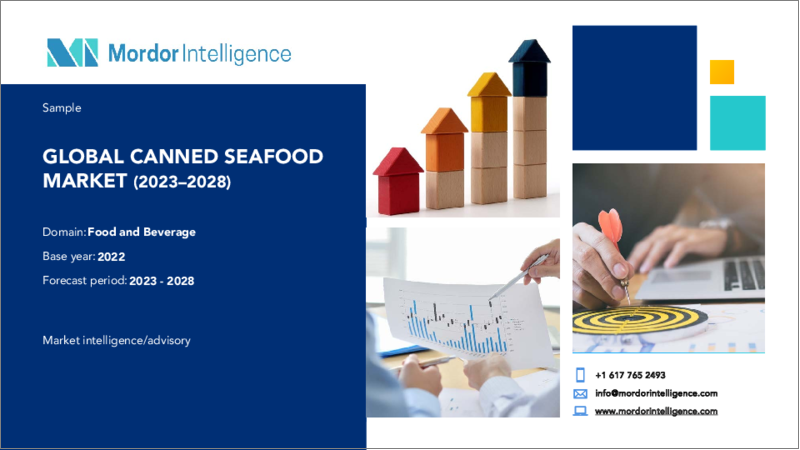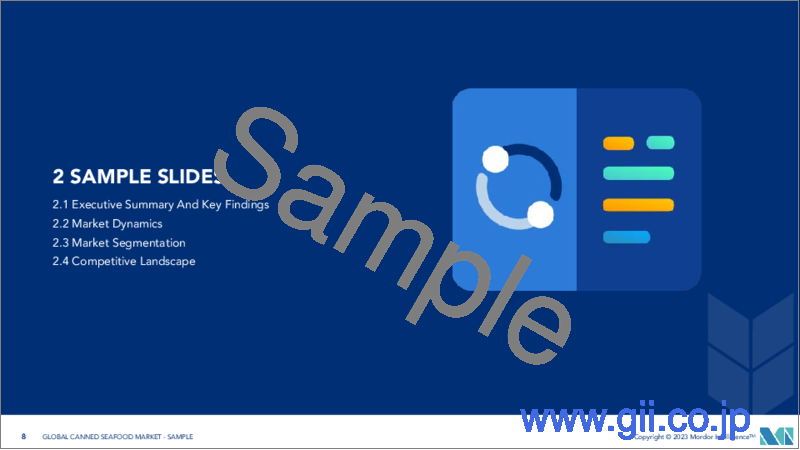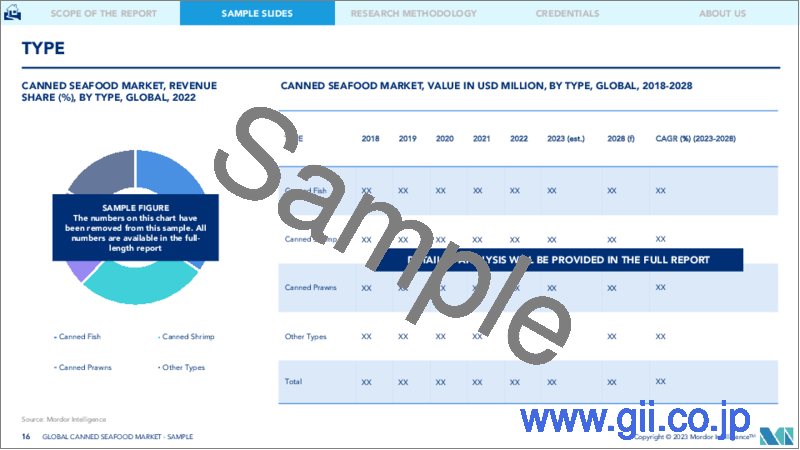|
|
市場調査レポート
商品コード
1190202
シーフード缶詰市場- 成長、動向、予測(2023年-2028年)Canned Seafood Market - Growth, Trends, and Forecasts (2023 - 2028) |
||||||
|
● お客様のご希望に応じて、既存データの加工や未掲載情報(例:国別セグメント)の追加などの対応が可能です。 詳細はお問い合わせください。 |
|||||||
| シーフード缶詰市場- 成長、動向、予測(2023年-2028年) |
|
出版日: 2023年01月18日
発行: Mordor Intelligence
ページ情報: 英文 130 Pages
納期: 2~3営業日
|
- 全表示
- 概要
- 目次
シーフード缶詰市場は、2022~2027年の予測期間中にCAGR6.06%を記録すると予測されています。
COVID-19のパンデミック時には、特に料理を作るのが苦手な消費者の間で、RTE食品の需要が急増しました。在宅勤務や外泊の傾向にある消費者は、調理が簡単で時間もかからないことから、調理済み食品を好みました。また、コロナウイルス感染者の増加を懸念して飲食店がサービスを制限していたため、消費者が家庭で調理することを主張し、中期的に調理済み食品の消費拡大につながっています。
また、ツナ缶を中心とした缶詰は、家庭内検疫や移動規制などの影響を受けている消費者に賞味期限の長さをアピールし、販売数を伸ばしました。
中期的には、シーフード缶詰の健康効果に対する認識が高まっており、シーフード缶詰市場の成長を促進しています。シーフード缶詰には、健康維持に重要なオメガ3脂肪酸が多く含まれています。目立つエキゾチックな食品の需要は、消費者の購買力の上昇の結果として増加傾向にあります。これにより、シーフード缶詰市場は目覚ましい成長機会を迎えようとしています。
シーフード缶詰市場の動向
利便性の高い食品への嗜好の高まり
可処分所得の増加や働く女性の増加に伴い、利便性が世界中でシーフード缶詰の消費を拡大させる主な要因となっています。ライフスタイルの変化と飲食品への支出の増加は、動物性食品、油脂、精製穀物、果物・野菜への需要の増加により、消費者の食生活に大きな変化をもたらしています。多忙な生活を送る人々、調理技術のない人々、ファーストライフ・スタイルによる疲労、および消費者の人口動態の変化が、コンビニエンス・フード市場の主な促進要因です。さらに、コロナウイルスの大流行が、戸締まりによる生鮮食料品の供給への影響から、消費者がシーフード缶詰などのコンビニエンス食品を消費するようになる原動力となっています。この時期、賞味期限の長い食品の重要性は最も高いものでした。
欧州が最大のシェアを占める
この地域では、調理済み食品や水産物の需要が高いことが、市場成長の原動力となっています。さらに、賞味期限の長い海産物に対する需要の高まりにより、シーフード缶詰の消費量も増加すると予想されます。同地域における主要な市場プレイヤーの存在と、可処分所得の増加および消費者のレディトゥコンシューマー食品への嗜好の高まりは、今後数年間における市場成長の主要因として浮上することが予想されます。また、高い健康効果をもたらすシーフードの消費量が増加していることも、業界の成長を後押しすると予想されます。同様に、メーカーはより多くの消費者層を魅了するシーフード缶詰製品に革新的な取り組みを行っています。例えば、2019年にGrupo Calvoは、Marine Stewardship Councilのラベルが付いたKatsuwonus pelamis種に属するマグロ缶詰を発売しました。この製品は、ガリシア州生態農業規制協議会認定の有機エクストラバージンオリーブオイルで包装されているなど、付加価値のある他の機能を消費者に提供しています。
シーフード缶詰市場の競合分析
水産物の市場は競争が激しく、大手企業は長期的な研究開発を強化し、製品開発に多額の投資を行っています。地域のプレーヤーとの戦略的提携や契約はまた、彼らの収入を増加させ、その地理的プレゼンスを広げるために、メーカーが好むアプローチのいくつかです。これらの経済における健康食品の消費に関する知識の成長所得レベルと増加のレベルでは、企業は世界中のシーフード缶詰のための人々の動的なニーズに応えています。市場の主要プレイヤーは、Thai Union Group, Bumble Bee Foods LLC, Maruha Nichiro Corporation, Maruha Nichiro Corporationです。
さらに、主要プレイヤーは、より多くの消費者を誘惑するために、水産物の持続可能な生産にも注力してきました。そのため、プレイヤーは、より高品質な製品を生産するために、加工技術や認証プロセスの改善に莫大な資本を投じています。例えば、2021年3月、ボルトングループブランドRio Mareは、国際認証機関であるDNVからEPD認証-環境製品宣言または環境製品宣言を取得し、したがって、この認証を持つ世界初の水産ブランドとなりました。
その他の特典
- エクセル形式の市場予測(ME)シート
- アナリストによる3ヶ月間のサポート
目次
第1章 イントロダクション
- 調査の前提条件と市場の定義
- 調査対象範囲
第2章 調査手法
第3章 エグゼクティブサマリー
第4章 市場力学
- 市場促進要因
- 市場抑制要因
- ポーターのファイブフォース分析
- 新規参入業者の脅威
- 買い手/消費者の交渉力
- 供給企業の交渉力
- 代替品の脅威
- 競争企業間の敵対関係
第5章 市場セグメンテーション
- タイプ別
- 魚の缶詰
- マグロ
- サーモン
- イワシ
- サバ
- えび缶
- その他のタイプ
- 魚の缶詰
- 流通経路別
- スーパーマーケット/ハイパーマーケット
- コンビニエンスストア
- ネット通販
- その他の流通経路
- 地域別
- 北米
- 米国
- カナダ
- メキシコ
- その他北米地域
- 欧州
- 英国
- ドイツ
- スペイン
- フランス
- イタリア
- ロシア
- その他欧州
- アジア太平洋地域
- 中国
- 日本
- インド
- オーストラリア
- その他アジア太平洋地域
- 南米
- ブラジル
- アルゼンチン
- その他の南米地域
- 中東・アフリカ地域
- アラブ首長国連邦
- 南アフリカ共和国
- その他の中東・アフリカ地域
- 北米
第6章 競合情勢
- 最も活発な企業
- 最も採用されている戦略
- 市場シェア分析
- 企業プロファイル
- Americana Group Inc.(California Garden)
- Thai Union Group(John West)
- Century Pacific Food Inc.
- Bolton Group(Rio Mare)
- Okam
- Dhofar Fisheries and Food Co. SAOG
- Dongwon Group
- Carvalho Fisheries
- FCF Co. Ltd(Bumble Bee Foods LLC)
- Trident Seafoods Corporation
第7章 市場機会と将来動向
第8章 COVID-19が市場に与える影響
The canned seafood market is projected to register a CAGR of 6.06% during the forecast period of 2022-2027.
The demand for ready-to-eat food products skyrocketed during the COVID-19 pandemic, especially among the consumers that are not fond of cooking food. Consumers following the trend of work-from-home or stay-at-home preferred ready-to-eat food as it is easy to prepare and takes minimal time. Additionally, the restaurants restricting services in fear of a rising number of coronavirus cases had insisted that consumers cook at home, thereby leading to an increase in the consumption of ready-to-eat products over the medium term.
Similarly, the sale of canned products, particularly canned tuna, increased as the long shelf life of such products appealed to consumers who were subjected to home quarantines, regulatory measures restricting ease of movement, and other impacts of government lockdowns.
Over the medium term, the rising awareness about the health benefits offered by canned seafood products is increasing the growth of the canned seafood market. Canned seafood has a high level of valuable omega-3 fatty acids, which are important for overall health and wellbeing. The demand for conspicuous and exotic food items is on the rise as a result of the rising purchase power of consumers. Spurred by this, the canned seafood market is poised to welcome impressive growth opportunities.
Canned Seafood Market Trends
Growing Preference for Convenience Food
Convenience is the key factor driving the growth of canned seafood consumption across the world, coupled with the increasing disposable income and a rise in the number of working women. Changes in lifestyles, coupled with increased expenditure on food and beverages, lead to significant dietary transitions among consumers, marked by the increased demand for animal-sourced food, fats and oils, refined grains, and fruits and vegetables. People with busy life schedules, those who lack cooking skills, fatigue due to the fast lifestyles, and the changes in consumers' demography are the major factors driving the convenience foods market. Furthermore, the coronavirus pandemic is a driving force encouraging consumers to shift to consuming convenience foods, such as canned seafood, as lockdowns impacted the supply of fresh food. The importance of long-shelf-life food was paramount during this period.
Europe Accounted for the Largest Share
The high demand for ready-to-eat meals and seafood products in the region is driving the market growth. Furthermore, a rise in demand for high-shelf life sea products is expected to result in increased consumption of canned seafood. The presence of major market players in the region, coupled with an increased disposable income and gyrating consumers' preference toward ready-to-consume food, is expected to emerge as the primary factor for market growth in the coming years. The increased consumption of seafood by the population owing to its high health benefits is anticipated to propel the industry's growth. Similarly, manufacturers are innovating in canned seafood products which attract a larger consumer base. For instance, in 2019, Grupo Calvo launched canned tuna belonging to the species Katsuwonus pelamis with a Marine Stewardship Council label. The product offers consumers other features with added value, including being packed in organic extra virgin olive oil certified by the Galician Regulatory Council of Ecological Agriculture.
Canned Seafood Market Competitive Analysis
The seafood market is highly competitive, with major players investing heavily in product development by strengthening their research and development initiatives for the long term. Strategic alliances and agreements with regional players are also some of the approaches preferred by the manufacturers to increase their revenue and widen their geographical presence. With growing income levels and an increasing level of knowledge regarding the consumption of healthy food in these economies, companies are catering to the dynamic needs of the people for canned seafood around the world. The major players in the market are Thai Union Group, Bumble Bee Foods LLC, Maruha Nichiro Corporation, and Maruha Nichiro Corporation.
Moreover, key players have also been focusing on the sustainable production of seafood products to entice more consumers. Thus, players have been investing huge capital in improving their processing techniques and certification processes to produce higher-quality products. For instance, in March 2021, Rio Mare, a Bolton group brand, obtained EPD certification - Environmental Product Declaration or Environmental Product Declaration from DNV, an international certification body, thus, becoming the first seafood brand in the world with this certification.
Additional Benefits:
- The market estimate (ME) sheet in Excel format
- 3 months of analyst support
TABLE OF CONTENTS
1 INTRODUCTION
- 1.1 Study Assumptions and Market Definition
- 1.2 Scope of the Study
2 RESEARCH METHODOLOGY
3 EXECUTIVE SUMMARY
4 MARKET DYNAMICS
- 4.1 Market Drivers
- 4.2 Market Restraints
- 4.3 Porter's Five Forces Analysis
- 4.3.1 Threat of New Entrants
- 4.3.2 Bargaining Power of Buyers/Consumers
- 4.3.3 Bargaining Power of Suppliers
- 4.3.4 Threat of Substitute Products
- 4.3.5 Intensity of Competitive Rivalry
5 MARKET SEGMENTATION
- 5.1 By Type
- 5.1.1 Canned Fish
- 5.1.1.1 Tuna
- 5.1.1.2 Salmon
- 5.1.1.3 Sardines
- 5.1.1.4 Mackerel
- 5.1.2 Canned Shrimp
- 5.1.3 Canned Prawns
- 5.1.4 Other Types
- 5.1.1 Canned Fish
- 5.2 By Distribution Channel
- 5.2.1 Supermarkets/Hypermarkets
- 5.2.2 Convenience Stores
- 5.2.3 Online Retail Stores
- 5.2.4 Other Distribution Channels
- 5.3 Geography
- 5.3.1 North America
- 5.3.1.1 United States
- 5.3.1.2 Canada
- 5.3.1.3 Mexico
- 5.3.1.4 Rest of North America
- 5.3.2 Europe
- 5.3.2.1 United Kingdom
- 5.3.2.2 Germany
- 5.3.2.3 Spain
- 5.3.2.4 France
- 5.3.2.5 Italy
- 5.3.2.6 Russia
- 5.3.2.7 Rest of Europe
- 5.3.3 Asia-Pacific
- 5.3.3.1 China
- 5.3.3.2 Japan
- 5.3.3.3 India
- 5.3.3.4 Australia
- 5.3.3.5 Rest of Asia-Pacific
- 5.3.4 South America
- 5.3.4.1 Brazil
- 5.3.4.2 Argentina
- 5.3.4.3 Rest of South America
- 5.3.5 Middle East & Africa
- 5.3.5.1 United Arab Emirates
- 5.3.5.2 South Africa
- 5.3.5.3 Rest of Middle East & Africa
- 5.3.1 North America
6 COMPETITIVE LANDSCAPE
- 6.1 Most Active Companies
- 6.2 Most Adopted Strategies
- 6.3 Market Share Analysis
- 6.4 Company Profiles
- 6.4.1 Americana Group Inc. (California Garden)
- 6.4.2 Thai Union Group (John West)
- 6.4.3 Century Pacific Food Inc.
- 6.4.4 Bolton Group (Rio Mare)
- 6.4.5 Okam
- 6.4.6 Dhofar Fisheries and Food Co. SAOG
- 6.4.7 Dongwon Group
- 6.4.8 Carvalho Fisheries
- 6.4.9 FCF Co. Ltd (Bumble Bee Foods LLC)
- 6.4.10 Trident Seafoods Corporation




